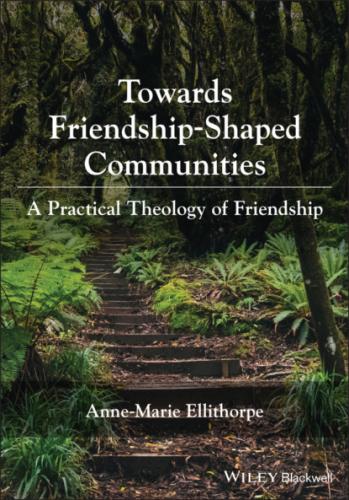14 14 Brandt, Among Friends?, 16.
15 15 Brandt, Among Friends?, 17.
16 16 Brandt, Among Friends?, 25.
17 17 John Terrell, A Talent for Friendship: Rediscovery of a Remarkable Trait (Oxford: Oxford University Press, 2014), 3.
18 18 Terrell, A Talent for Friendship, 5.
19 19 Terrell, A Talent for Friendship, 17.
20 20 This fact flies in the face of centuries of the widespread prejudice which perceives New Guinea as a place where savage violence, treachery, cannibalism, and warfare predominate.
21 21 Terrell, A Talent for Friendship, 93.
22 22 Speaking of a view of human origins derived from Genesis 2, Terrell observes: “It is not surprising that Enlightenment thinkers would take it as read that human beings living in a state of nature would be able to survive as solitary forest creatures or as close-knit families on their own divorced from any need to associate with other people. After all, hadn’t this first couple done so quite handily?” Terrell, A Talent for Friendship, 14, 190.
23 23 Terrell, A Talent for Friendship, 14.
24 24 Georg Simmel and Everett C. Hughes, “The Sociology of Sociability,” American Journal of Sociology 55, no. 3 (1949): 257.
25 25 Georg Simmel, “The Sociology of Secrecy and of Secret Societies,” American Journal of Sociology 11, no. 4 (1906): 458.
26 26 Simmel, “The Sociology of Secrecy and of Secret Societies,” 458.
27 27 Graham Allan and Rebecca G. Adams, “The Sociology of Friendship,” in 21st Century Sociology: A Reference Handbook, ed. Clifton D. Bryant and Dennis L. Peck (Thousand Oaks, CA: Sage, 2007), 123.
28 28 Ray Pahl, On Friendship (Malden: Blackwell, 2000), 36. The analysis of friendship continues to be marginal in mainstream sociology. See Alice P. Julier, Eating Together: Food, Friendship, and Inequality (Urbana: University of Illinois Press, 2013), 2.
29 29 See Sara H. Konrath, Edward H. O’Brien, and Courtney Hsing, “Changes in Dispositional Empathy in American College Students Over Time: A Meta-Analysis,” Personality and Social Psychology Review 15, no. 2 (2011).
30 30 Miller McPherson, Lynn Smith-Lovin, and Matthew E. Brashears, “Social Isolation in America: Changes in Core Discussion Networks over Two Decades,” ASR 71, no. 3 (2006).
31 31 Anthony Paik and Kenneth Sanchagrin, “Social Isolation in America: An Artifact,” ASR 78, no. 3 (2013): 339. Ivaylo Petev’s research corroborates these trends of civic disengagement and social isolation. Ivaylo D. Petev, “The Association of Social Class and Lifestyles: Persistence in American Sociability, 1974 to 2010,” ASR 78, no. 4 (2013). However, Anthony Paik and Kenneth Sanchagrin assert that interviewer effects, including interviewer training and interviewer fatigue, bias many estimates of social connectivity. See Paik and Sanchagrin, “Social Isolation in America: An Artifact,” 353–355.
32 32 Ray Pahl and Liz Spencer, “Family, Friends, and Personal Communities: Changing Models‐in‐the‐Mind,” Journal of Family Theory & Review 2, no. 3 (2010): 197.
33 33 Liz Spencer and Ray Pahl, Rethinking Friendship: Hidden Solidarities Today, 190–212.
34 34 Pahl, On Friendship, 43.
35 35 Pahl, On Friendship, 73.
36 36 Pahl, On Friendship, 64.
37 37 Frank Bruni, “How Facebook Warps Our Worlds,” The New York Times, 21 May 2016.
38 38 Diane Jeske, Friendship and Social Media: A Philosophical Exploration (New York: Routledge, 2019), 133.
39 39 The widespread usage of smart phones and social media has had a further benefit, in that these forms of technology have enabled the capture and sharing of life-threatening (or life-ending) acts of injustice, allowing citizens to see racial disparities and police brutality with their own eyes and provoking citizens to engage in acts of solidarity. See Walker-Barnes, Voices of My People, 21. On the other hand, widespread sharing can also have a retraumatizing impact.
40 40 Mark Zuckerberg, “Is Connectivity a Human Right,” https://www.facebook.com/isconnectivityahumanright. Accessed 4 October, 2021.
41 41 “Facebook Investor Relations,” https://investor.fb.com/resources/default.aspx. Accessed 4 October 2021.
42 42 Jill Lepore, “Facebook’s Broken Vows: How the Company’s Pledge to bring the World Together Wound Up Pulling Us Apart,” New Yorker, https://www.newyorker.com/magazine/2021/08/02/facebooks-broken-vows. Accessed 4 October 2021.
43 43 Lepore, “Facebook’s Broken Vows,” 4 October 2021.
44 44 See Jeske, Friendship and Social Media.
45 45 John Fitzgerald, “Christian Friendship: John, Paul, and the Philippians,” Interpretation 61, no. 3 (2007): 284.
46 46 Fleming Rutledge, The Battle for Middle-Earth: Tolkien’s Divine Design in The Lord of the Rings (Grand Rapids: Eerdmans, 2004), 6, 30.
47 47 Rutledge, Battle, 78.
48 48
